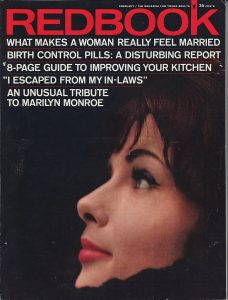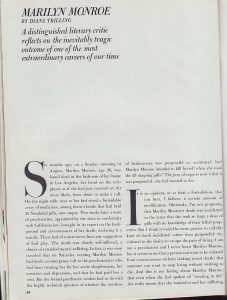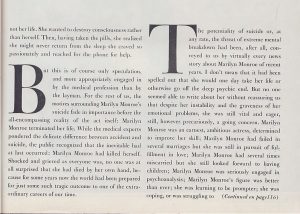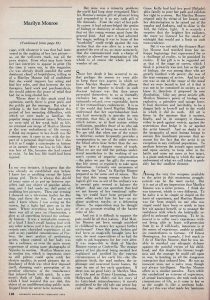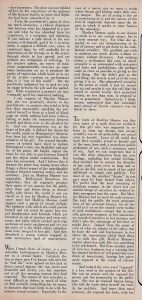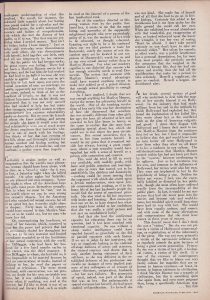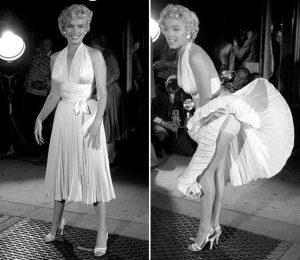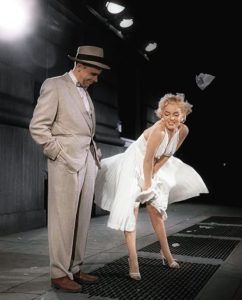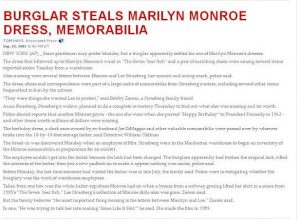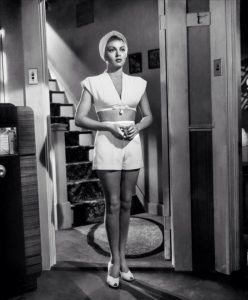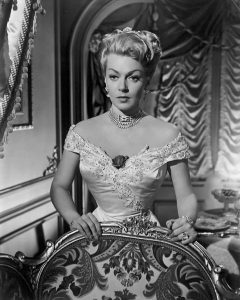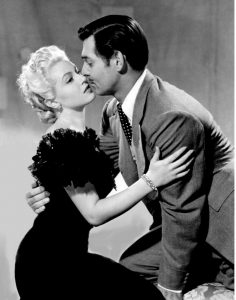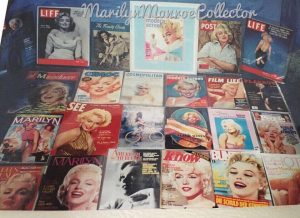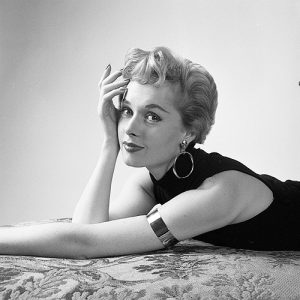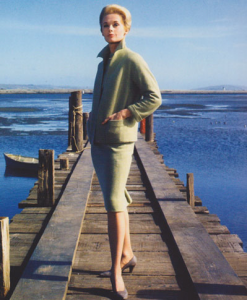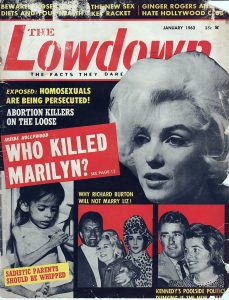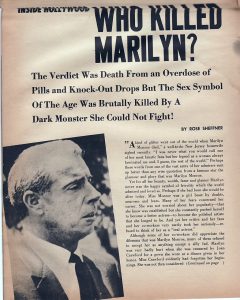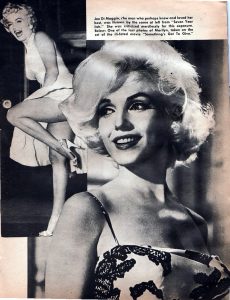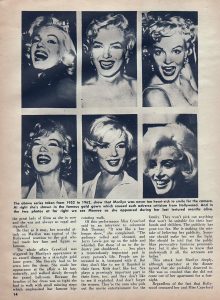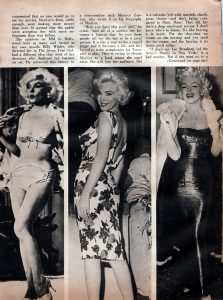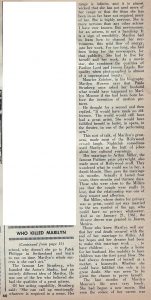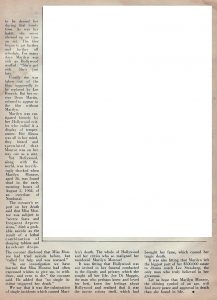
The white pleated halter dress that Marilyn Monroe wore in The Seven Year Itch is always described in superlatives: most iconic, most recognized, most recreated, most expensive. It can also be called the most mysterious: how many copies of the dress were there? Is there another one in existence, hidden away all these years? Did Marilyn herself own a copy of the dress, and if so, where did it end up? And perhaps most intriguing: was a copy of the dress really stolen back in 1993?
In 2011, The Seven Year Itch dress was sold to great fanfare for an astounding $5.6 million. It had been part of the Debbie Reynolds collection, obtained by her during studio sell offs of costumes in previous decades. Astute Marilyn fans noticed that there were some discrepancies between the dress being auctioned and the one Marilyn appeared to be wearing. For cost saving measures, studios would reuse costumes, making alterations as needed, and this was no exception: the dress was altered and worn by Roxanne Arlen in the film Bachelor Flat in 1962, and this was the dress in Reynold’s collection. Scott Fortner investigated extensively and was able to prove beyond doubt that the dress auctioned was in fact one that was worn by Marilyn and was also confirmed by the designer, William Travilla, himself.So it would appear that the dress auctioned is authentic, alterations and all. You can read Scott’s detailed research here.
However, Scott’s research raised some more questions, especially after it was revealed in Travilla’s notes that he had actually made four copies of the famous dress. It would make sense that one was used on location in New York, and another for the reshoots of the scene in Los Angeles. So where are the other dresses, if they exist?
When Marilyn Monroe died, her Last Will and Testament stated “I give and bequeath all of my personal effects and clothing to LEE STRASBERG, or if he should predecease me, then to my Executor hereinafter named, it being my desire that he distribute these, in his sole discretion, among my friends, colleagues and those to whom I am devoted.” Rather than distributing these items to her friends, Lee had everything from her Los Angeles home and her New York apartment placed in storage. Two years after the death of his wife Paula in 1966, Lee married Anna Mizrahi, a woman 38 years his junior. They met when Anna, an aspiring actress, auditioned for a place at The Actor’s Studio. When Lee died in 1982 his entire estate, which included Marilyn’s belongings, was inherited by Anna. Anna Strasberg has been a controversial figure, as she held sole rights to Marilyn’s belongings, name, image, and licensing and ruled them with a litigious iron fist although she had never even met her. Lawsuits were filed against anyone who attempted to use Marilyn for commercial gain, including a drawn out battle with Marilyn’s photographers over who retained the rights to their photos: the photographers who took them or Anna, as they contained Marilyn’s image. (the photographers won). In 1999, following Joe Dimaggio’s death, Anna cosigned the majority of Marilyn’s belongings that had been warehoused to Christie’s Auctions for the now legendary $13 million sale. However, a few years prior to that we gained some clues as to the whereabouts of a second Seven Year Itch dress.
On September 13, 1993 a stolen property report came in to the 10th Precinct of the New York Police Department. A storage unit had been burglarized, and some cartons had been stolen. A pretty nondescript crime, except those cartons contained the personal property of Marilyn Monroe. The report was filed by none other than Anna Strasberg. She kept several boxes of Marilyn’s things in a seventh floor storage locker at Chelsea Mini-Storage on West 28th Street. An employee had gone to do an inventory report for an upcoming exhibit and discovered that there was a new lock on the door and cartons were missing. Evidently a burglar had cut the lock, stolen 3 or 4 (reports vary) boxes of priceless Marilyn memorabilia, and then took the time to put a new lock on the unit. The last time the items had been checked on was late July, so the crime could have occurred at any time in the previous six weeks.
Initial news reports on September 15 claimed that items listed as missing were letters between Marilyn and Lee Strasberg, the sequinned Jean Louis dress that she wore when she sang Happy Birthday to President Kennedy, and the dress and shoes from The Seven Year Itch. However, the following day Detective William Oldham of the Major Case Squad stated to the press that reports that the Happy Birthday dress was missing were false.
Thomas O’Malley, a detective with over 20 years on the police force, was assigned the case of the missing Monroe items. He spent six and a half months tracking down clues and investigating who had stolen the Marilyn items and where they were now, and the pressure was on for him to find the most valuable missing items: Marilyn’s white pleated dress and shoes from The Seven Year Itch. As he pursued leads, the local and national newspapers all reported on the theft of the most recognizable film costume of all time. O’Malley searched out witnesses, fingerprinted the scene, checked the storage facility’s customer list, and interrogated prisoners. Eventually he got a lead that seemed worthwhile: a prisoner told him that it had been a crime of opportunity, and the thief was someone named Jesus Davila. After discovering that Davila had a previous arrest for burglary of a storage unit and had a rented unit on the same floor of the storage facility as Anna, O’Malley felt he had his man.
 On March 28, 1994, armed with a search warrant, O’Malley entered Davila’s storage unit and immediately spotted boxes with Anna’s name and address on them contained within. O’Malley called Anna in California with the good news and asked her to send a representative over to identify the stolen property. Eagerly awaiting a look inside the boxes, O’Malley wholeheartedly hoped that the Seven Year Itch dress had been recovered. “Not just for Anna’s sake, not just to do my job as a detective, but for Marilyn Monroe herself,” he said. “The dress is a piece of movie history, and a symbol of its sexiest star.”
On March 28, 1994, armed with a search warrant, O’Malley entered Davila’s storage unit and immediately spotted boxes with Anna’s name and address on them contained within. O’Malley called Anna in California with the good news and asked her to send a representative over to identify the stolen property. Eagerly awaiting a look inside the boxes, O’Malley wholeheartedly hoped that the Seven Year Itch dress had been recovered. “Not just for Anna’s sake, not just to do my job as a detective, but for Marilyn Monroe herself,” he said. “The dress is a piece of movie history, and a symbol of its sexiest star.”
The representative arrived and the boxes were opened. The famous dress was not there.
The next day, March 29, O’Malley arrived at St. Luke’s -Roosevelt hospital, where Jesus Davila worked, to make the arrest. Davila quickly confessed to committing the crime and said that he had given some of Marilyn’s things to his coworkers and a neighbor in his building. They were told they had until 8 o’clock that evening to return everything or face charges of receiving stolen goods themselves.
Back at the precinct, Davila offered more details of the crime. He had clipped the lock on Anna’s storage unit and removed the boxes, but claimed he had no idea what was in them until the press reported that the theft was of Marilyn Monroe’s property. He then moved some of the items to his home, and gave some away as gifts. Davila consented to having the officers escort him to his apartment to do a search and recover the stolen goods, and that search was conducted at 4:40 pm on March 29. Nothing was found in Davila’s apartment, but the neighbor Davila had given items to brought down a black plastic bag and handed it over to the detectives. It contained a few hats, a fur piece, and some plates but no white pleated dress and Davila was not forthcoming about it’s whereabouts.
The press reported on the items recovered but noted that the Seven Year Itch dress was still missing. O’Malley was taken aback when his superiors told him to stop working to recover the dress. They were claiming the the new ”official” story was that the dress and shoes had been located in Anna’s storage unit after all. The detective was initially startled by this pronouncement, but after all his years as a detective thought he had figured out what had happened.
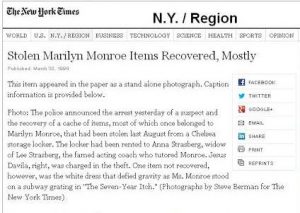 In an interview in 2000 about the case of the missing dress, O’Malley used the following analogy:
In an interview in 2000 about the case of the missing dress, O’Malley used the following analogy:
“If a stamp collection with one world famous stamp were stolen and most of it recovered except the premier stamp, the owner would of course do anything to get it back; and if the perp had a half decent lawyer, he would know that stamp was his bargaining chip. The lawyer could offer to return the stamp provided his client didn’t get any jail time. Probation, maybe, but no jail time.
{As far as the dress} Here’s a guy who got himself a get-out-of-jail-free card.
Lawyers make deals with the district attorney’s office, they don’t make deals with the police department. The DA has the last lick. So if a cop is looking for a world famous stamp and the DA tells him to stop poking around, what’s he to do but stop looking?
But how do you explain the stamp all of a sudden showing up? Of course, the media is going to ask the police if they recovered the stamp. The detective would respond “I never recovered the stamp”. So the media would say “Wait a minute, what’s going on here? If the police didn’t recover it, how was it found?’ To save face, the DA might say “The stamp was reported stolen in error. It was in the back of the safe, and we didn’t see it. But it was always there.The owner’s got his stamp back, the perp does soft time, the district attorney is happy because the case is closed with probation, and the police department is happy because the case is closed.”
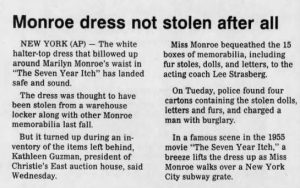 Detective O’Malley was interviewed for this article. He speaks in the no nonsense way that one would expect from a New Yorker with years on the police force, but his story remains absolutely consistent with both the published reports at the time and later interviews he gave about the missing dress. “We checked the guy’s apartment, there wasn’t much there. He didn’t keep the stuff. He put it in an upstairs apartment, we went there and found everything. The DA and I sat down and she said ‘Tommy, you got him good.” He couldn’t say he didn’t do it, everything led to him. We found it in the storage bin in his name and got a confession from him. I had it locked down,a done deal. The perp was charged with grand larceny and burglary also.”
Detective O’Malley was interviewed for this article. He speaks in the no nonsense way that one would expect from a New Yorker with years on the police force, but his story remains absolutely consistent with both the published reports at the time and later interviews he gave about the missing dress. “We checked the guy’s apartment, there wasn’t much there. He didn’t keep the stuff. He put it in an upstairs apartment, we went there and found everything. The DA and I sat down and she said ‘Tommy, you got him good.” He couldn’t say he didn’t do it, everything led to him. We found it in the storage bin in his name and got a confession from him. I had it locked down,a done deal. The perp was charged with grand larceny and burglary also.”
He goes on to reiterate how he was told lay off anything to do with the famous white dress, which was not recovered at Davila’s apartment building. “I get a call from DA, she says the dress will be recovered. It was the only thing that was still missing but I was told to stop working the case. I asked “How are you going to put that into play?” She says to go see Anna Strasberg and talk to her. So I go see her at her apartment. She tells me it was never missing, I always had it. I didn’t believe her, but she insisted, so that’s how it’s going to be. If it’s not missing, and she has it, that’s it, case closed. All she really wanted was the dress, that’s why it was big time publicized and in all the papers at the time. I could have made a big stink, but it was considered closed and I had other cases to get to.”
He repeats his earlier theory that the dress was used as a bargaining chip to get a plea deal: “I think the guy’s lawyer convinced him to return the dress to her, she says it’s her mistake, it was never actually stolen. The DA went along with it, the whole case is dismissed. They worked out a deal, I see it all the time. I don’t think he even did any time for it. That’s how you get out of doing time for stealing a million dollar dress.”
O’Malley’s theory seems plausible,which would mean that the second Seven Year Itch dress is safely with Anna Strasberg and we may never know if it was actually stolen or not. However, there’s one more bit of intrigue to the Seven Year saga…..sources have said that Anna Strasberg not only says that she does not currently have a Seven Year Itch dress, she claims that she NEVER had a Seven Year Itch dress. I asked Detective O’Malley why he thought it would be claimed that she never owned the dress and while he was reluctant to speculate, he did state that maybe it had simply been sold privately some time ago and that both Anna and the new owner didn’t want that publicized.
Anna cosigned what is believed to be the remainder of Marilyn’s personal items to Julien’s Auctions for a November 2016 sale and there is certainly no Seven Year Itch dress among the lots. Which begs the question….does Anna in fact have the dress and is withholding that information for reasons known only to her? Did she have it in 1994 but no longer has it today? Or, is she being truthful in stating that she has never had one….but then how does that explain the police report, filed by Anna Strasberg personally according to Detective O’Malley, stating that it was missing? Stoically reluctant to answer questions pertaining to Marilyn on the record, we may never know from Anna herself. While it’s highly likely that there is more than one copy of the dress, until it surfaces and brings it’s story with it, all we can do is speculate on who has it and where it is now.
By Marijane Gray for Immortal Marilyn

Life and Career
Lana was born Julia Jean Turner of Wallace, Idaho in 1921. Her father was murdered in 1930, and a year later, she moved to Los Angeles with her mother. Turner’s ‘discovery’ – while sipping a Coke at the soda fountain outside the Top Hat Café on Sunset Boulevard and after skipping a typing class – is the stuff of legend. She was just sixteen years old. Billy Wilkerson, publisher of the Hollywood Reporter, was struck by her youthful good looks, and in 1937 she was signed by MGM under a new name, ‘Lana’.
While initially more celebrated for her looks than her acting, Lana proved her critics wrong with a dramatic turn as an alcoholic starlet in Ziegfeld Girl (1941.) Perhaps her best-known performance is as the adulterous Cora Smith in the classic thriller, The Postman Always Rings Twice (1946.)
Turner married seven times, and once said of her many failed relationships, “I’m so gullible. I’m so damn gullible. And I am so sick of me being gullible.” In 1957, her teenage daughter was charged with stabbing Lana’s boyfriend, gangster Johnny Stompanato, to death after she found him beating her. It was later ruled as justifiable homicide.
She earned acclaim for her performances in The Bad and the Beautiful (1952), Peyton Place (1957), Imitation of Life (1959), and Madame X (1966.) Turner’s career continued until the early 1980s, when she acted in TV soap opera Falcon Crest. She died in 1994.
Marilyn Connections
Sweater Girls: In her movie debut, They Won’t Forget (1937), Lana played a character loosely based on Mary Phagan, whose murder in 1913 led to the lynching of an innocent man. Lana’s first scene, in which she walked down a street wearing a form-fitting top, led to her being labelled ‘The Sweater Girl’, a name she detested. This trend was later adopted by Marilyn. She joked about it during a performance for US troops in 1952: “You fellows are always talking about sweater girls. I don’t know what the fuss is about. Take away their sweaters and what have they got?”
Mickey Rooney: Another of Lana’s early films was Love Finds Andy Hardy (1938), with Judy Garland and Mickey Rooney, America’s most popular young star at the time. In his 1991 autobiography, Life is Too Short, Rooney claimed that he and Lana had an affair and that she aborted his baby. “Mother was livid and adamantly denied it,” Cheryl Crane noted. “I know that it was very important to her to fight this accusation because she even phoned her attorney … If Rooney’s story had been true and she wanted to keep it a secret, it would have been more like her to act as though he didn’t exist.”
Rooney also claimed an affair with Marilyn, and even that he invented her name. In the latter case, it is well-known that her name was created in 1946 by Marilyn herself and the Fox talent chief, Ben Lyon. (‘Marilyn’ was inspired by a Broadway star of the 1920s, Marilyn Miller, while ‘Monroe’ was the maiden name of Marilyn’s own mother.
MGM: As her career rocketed during the early 1940s, Lana was managed by Johnny Hyde, “a dear friend for years” according to Cheryl Crane. In 1949, Hyde met Marilyn in Palm Springs, and was instantly smitten. “He said that he had discovered Lana Turner and other stars,” she recalled, “and that I had more than Lana and it was a cinch I would go far.”
Marilyn had sought an MGM contract as early as 1947, while under the management of Lucille Ryman Carroll, a talent scout for the studio. Ryman had earlier served as a mentor to Lana Turner. But with Lana on their payroll, the studio didn’t need another sexy blonde. Then in 1950, Johnny Hyde secured a breakthrough role for Marilyn in MGM’s The Asphalt Jungle. All that year, Hyde tried to negotiate with Dore Schary to take on Marilyn permanently. But though Monroe would make two more films for MGM – Right Cross and Hometown Story – Schary wasn’t interested.
When Lana’s career began, MGM was Hollywood’s most lavish studio. Marilyn, on the other hand, made her name at Fox during the 1950s, when the studio system was in decline. She never enjoyed the protection that stars of Turner’s generation had.
In 1951, Dore Schary replaced Louis B. Mayer as head of MGM. Lana felt unsupported by Schary, and left the studio for good in 1956.
Drama Queens: Turner was generally cast in romantic dramas, but Monroe also shone in comedies and musicals. Of all the roles she played, the most similar to Lana’s characters was that of amoral Rose Loomis in the film noir, Niagara (1953.) Like Cora in The Postman Always Rings Twice, Rose persuades her lover to murder her husband. While Niagara was not as compelling as Postman, it looked spectacular and in one famous scene, Marilyn was filmed taking the longest walk in cinematic history.
Lana was also famed for her style of walking. “She would try to teach it to me, but I never quite got the hang of it,” Cheryl Crane admitted. “It was a manner of twisting the ball of the foot with each step. One unusual feature of hers that had an effect on it was that her left leg was a bit shorter than the right … She also wore high heels, usually four inches, sometimes with platforms. Hers was a rolling, subtle kind of glide, not a hip-swinging Marilyn Monroe walk.”
Dancing Girls: Though Lana, unlike Marilyn, was not an outstanding singer, she danced superbly and was once nicknamed Hollywood’s ‘Nightclub Queen’. In The Merry Widow (1952), she worked with choreographer Jack Cole. “The Waltz musical sequence featured a chorus of beautiful dancers dashing about all in pink,” author Cindy De La Hoz observed. “It appears Cole looked back to his work in these moments the following year in his choreography of Marilyn Monroe’s ‘Diamonds Are a Girl’s Best Friend’ number” (in Gentlemen Prefer Blondes.)
Betty Grable: From the 1940s onward, Lana was friendly with another glamorous blonde, Betty Grable. ‘At the height of their fame, fans who ran into them would mistake them each other occasionally,’ Cheryl Crane revealed. ‘Mother happily obliged them with a “Betty Grable” autograph.’ Monroe, who was often shy around others, nonetheless bonded with Grable when they starred together in How to Marry a Millionaire (1953.)
Otto Preminger: Marilyn’s 1954 western, River of No Return, was by her own estimation, “a grade-Z cowboy movie.” Director Otto Preminger bullied Monroe, and she reputedly considered him ‘a pompous ass’. In 1958, Lana was offered a role in one of Preminger’s best films, Anatomy of a Murder. After clashing with Preminger over her wardrobe demands, however, Turner rejected the part, and later reflected, “God forbid my family should ever be so hungry that I have to work for him.”
Clark Gable: In 1941, Lana starred alongside the ‘King of Hollywood’, Clark Gable, in Honky Tonk, a western which became MGM’s highest grossing movie that year. She and Gable were featured on the cover of Life magazine, and went on to make three more films together. Gable and Turner were branded ‘The Team that Generates Steam’. In 1942, while they were filming Somewhere I’ll Find You, Gable’s wife, actress Carole Lombard, was killed in a plane crash. Gossip spread that Lombard had taken an early flight because she was nervous about leaving Gable ‘alone with Lana Turner,’ which she denied.
Gable was one of Marilyn’s childhood idols, and she realised her dream of working with him with The Misfits in 1960. Sadly, it was to be the last film either star would complete. Gable died of a heart attack shortly after filming ended, and Marilyn was devastated by reports that Gable’s widow, Kay Spreckles, blamed his collapse on Marilyn’s erratic behaviour during filming. But Kay later reassured Marilyn by inviting her to the christening of Gable’s son.
Children: Lana’s chronic endometriosis made her unable to have more children, but she remained close to daughter Cheryl throughout her life. Marilyn, who also suffered from endometriosis, endured at least two painful miscarriages and would never have children of her own.
Legends: In Lana: The Memories, the Myths, the Movies, co-written with Cindy De La Hoz (author of two books on Monroe), Cheryl Crane states that her mother “thought Marilyn Monroe was a fine actress besides being a fascinating personality.”
Marilyn’s death is considered one of Hollywood’s greatest tragedies. While Lana never found lasting love, ultimately she survived. Both women came from humble backgrounds, and achieved immense fame through their beauty and talent. Like so many sex symbols, they were rarely given the respect they deserved, and their difficult private lives contrasted poignantly with the upfront glamour they projected.
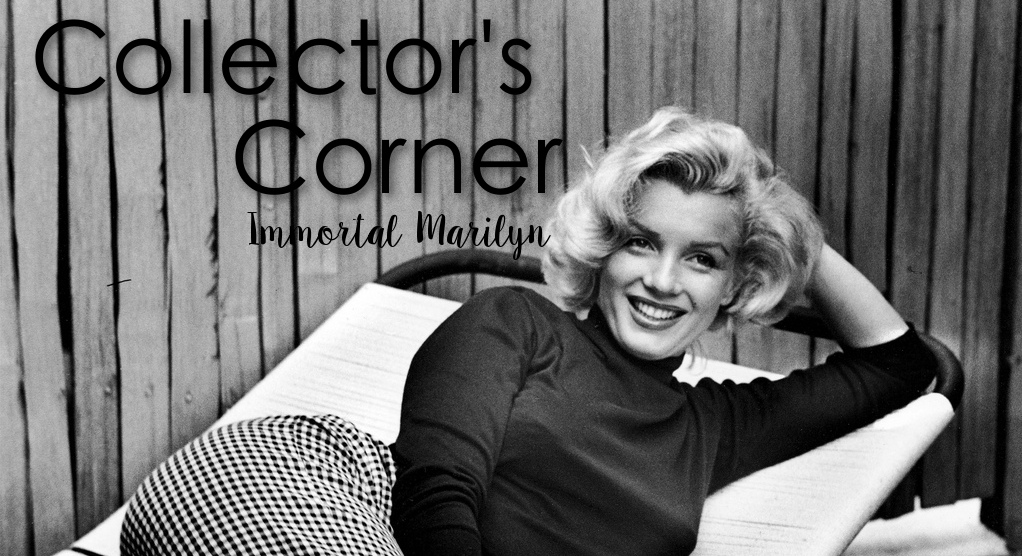
Welcome back to Collector’s Corner! This month we meet lifelong fan Kimmarie DePalma.
How long have you been collecting?
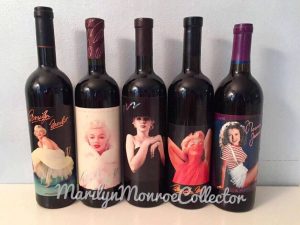
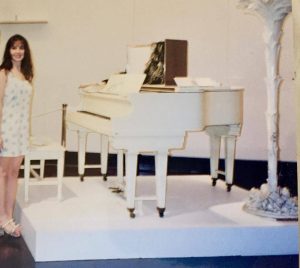 I was born into collecting Marilyn. My father loved Marilyn as a kid, and collected her photos and books. I grew up with framed photos of Marilyn all over my childhood home. I have a photo of myself when I was 7 years old standing next to a Marilyn picture. In 1989, I started building my own collection.
I was born into collecting Marilyn. My father loved Marilyn as a kid, and collected her photos and books. I grew up with framed photos of Marilyn all over my childhood home. I have a photo of myself when I was 7 years old standing next to a Marilyn picture. In 1989, I started building my own collection.
What is in your collection? Do you focus on one particular area or collect all kinds?
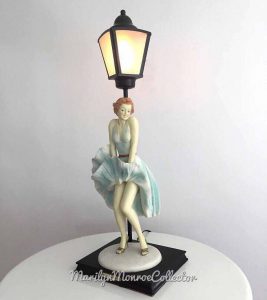 You can say I collect all kinds of her merchandise, but my favorite are vintage magazines.
You can say I collect all kinds of her merchandise, but my favorite are vintage magazines.
My collection consists of magazines, collector plate sets, Marilyn Merlot wine, porcelain dolls, vinyl dolls, vintage ads, pool cues, statues, lamps, books, some signed by the authors. Photos and art. Marilyn dinnerware and champagne glasses with Andy Warhol art. Christmas ornaments, cross stitch, stamps, collector card sets and Marilyn inspired clothing by Warners.
What is your most prized possession?
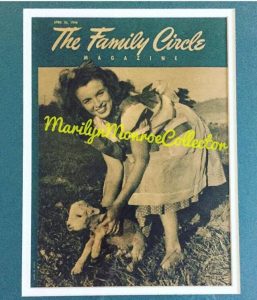 My most prized item is Marilyn’s 1946 Family Circle magazine in mint condition that I won at an auction in 1993. I love that there is a photo of her posing with this magazine. I also treasure a calendar I have of her from 1953, as Norma Jeane posing with a Great Dane.
My most prized item is Marilyn’s 1946 Family Circle magazine in mint condition that I won at an auction in 1993. I love that there is a photo of her posing with this magazine. I also treasure a calendar I have of her from 1953, as Norma Jeane posing with a Great Dane.
What would you like most to add to your collection?
What I want the most for my collection was sold at the Christie’s auction in 1999. Marilyn’s platinum diamond wedding band from Joe DiMaggio. When I went to Christie’s Auction in July 1999, I couldn’t stop looking at it. Joe DiMaggio was my favorite husband of Marilyn’s.
Any advice to new collectors?
My advice to new collectors is to display your collection, and enjoy it as much as possible. My collection is in storage, so I don’t get to enjoy it as much as I used to.
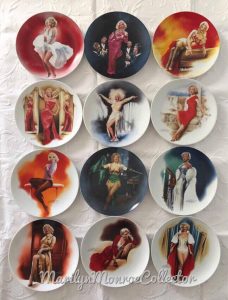 What do your friends and family think of your Marilyn collection?
What do your friends and family think of your Marilyn collection?
My friends and family are so used to me loving Marilyn. My husband, who was my boyfriend in 1999, was the one who took me to Christie’s each day to see her items. It was en experience I’ll never forget. Especially seeing her Happy Birthday President dress being sold for the first time. It’s always nice when someone tells me when they see Marilyn, they think of me. But- only true fans understand what’s it’s like to be in love with a girl named Marilyn.
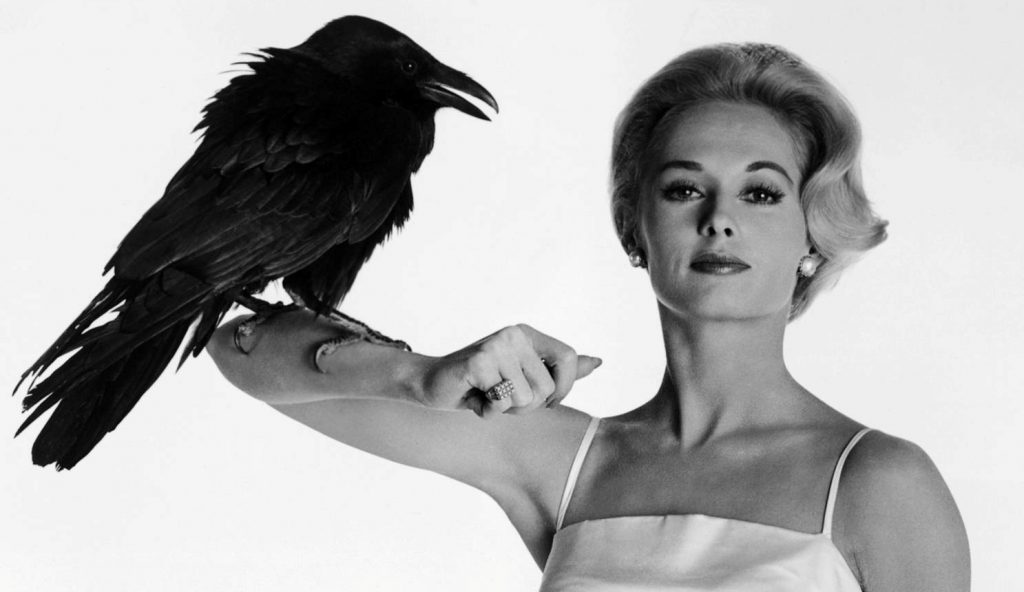
Life and Career
Nathalie Kay Hedren was born in the small town of Lafayette, Minnesota, on January 19, 1930 to parents Dorothea and Bernard Hedren, becoming the baby sister to Patricia Hedren, who was four years older. The name change to “Tippi” came not from a studio, but from her adoring father, who called her tupsa as a child, the Swedish term for “little sweetheart,” which soon evolved into “Tippi.”
Tippi was incredibly shy as a child, but quickly developed a passion for figure skating, fantasizing about one day becoming a professional figure skater when she grew up.However, once a severe inflammation in her left heel prevented her from escaping to her favorite childhood hobby for a long while, she decided to consider other career opportunities, until a chance meeting on her route home from school.No sooner had Tippi stepped inside the local drugstore did a woman she’d never met approach her and hand her a business card. She wanted Tippi to model in the town’s fashion shows. Tippi was overjoyed, and soon fell in love with the business, and her hard work paid off. She was earning money and experience through several modeling jobs, a career path she embraced for about ten years.
After graduating high school in 1947 and briefly attending Pasadena City College, she received a call from Eileen Ford of the Ford Modeling Agency in New York. Ford was interested in meeting Tippi, who had phoned a few weeks before. The hopeful model immediately boarded a train straight to the east coast.While working for Ford, she gained valuable modeling experience, was taught by the best, and was always booking jobs.
While on set for a small role in the TV series The Aldrich Family, Tippi met Peter Griffith, a former child actor, and the two quickly fell in love after he saved her from falling off of a stage. The couple married in 1952, and in 1956, Tippi learned she was pregnant.
Daughter Melanie Griffith was born on August 9th, 1957, and became the ultimate source of happiness in Tippi’s life. “Melanie Griffith was and is my great fortune, my best friend, my love, my luckiest blessing in a life that’s been filled with them.”
Unfortunately, Tippi and Peter’s marriage wasn’t doing so well. Peter was unfaithful and was hardly around. In 1961, Tippi obtained a divorce, and she soon took Melanie and made the move to Los Angeles, where the next major chapter in her life would begin.
On October 13, 1961, after Tippi was settled on the west coast, she received a call. A representative of MCA was on the line, asking if she was the girl that had appeared in a recent Sego diet drink commercial. Apparently, a powerful director in Hollywood was interested in meeting her, but she would not see this person face-to-face until she was already under contract.
That man was the legendary Alfred Hitchcock. Once her contract was signed without much hesitation, she was on her way to Paramount Studios to meet with the infamous director. The two enjoyed a pleasant conversation over lunch and not once spoke about acting, a field which Tippi had virtually zero experience in. All she knew was that she was now under a lucrative contract, which was about to provide her the money she needed to take care of herself and her young daughter. Although she did not expect to become such a prominent Hollywood star, she was excited about the prospect of working with such a reputable and talented man, trying out real acting, and being able to provide for her family after their big move.
The filming of her only two Hitchcock films was a complete nightmare. At first, Tippi was beyond elated; Hitch wanted her to star in his next big thriller: The Birds. What should have been a rewarding experience turned into a horrible couple of years. Hitchcock soon became obsessed with the young blonde, stalking her and making unwanted sexual advances on her. She firmly refused him multiple times, and he became angry with her. As a result, he made her days on set as aggravating as possible. In one famous incident, he replaced the mechanical birds that should have been used during an attack scene, with real ones. “The [attack] scene lasted a minute in the final cut of The Birds. Hitchcock spent five days filming it before he finally decided he had all he wanted.” Despite the horror she was enduring, Tippi courageously kept returning to work, and soon dove into her final Hitchcock film: Marnie.
In her 2016 memoir, she speaks of one incident during Marnie: “I’ll simply say that he suddenly grabbed me and put his hands on me. It was sexual, it was perverse, and it was ugly, and I couldn’t have been more shocked and more repulsed.”
Once Marnie was finished, Tippi demanded to be let go from her contract, and Hitchock made a promise that he would ruin her career. He did for a while, turning down big names and offers for Tippi to appear in various films and at various events while she was still under contract. Even though those few years were a nightmare, Tippi was still grateful that he had given her a chance as an unknown, and for teaching her valuable acting techniques.
The next life journey she would embark on would be a wild one. In 1964, Tippi married for the second time, to her agent, Noel Marshall. Not long after, she was offered to star in a film called Satan’s Harvest, which would be shot on location in South Africa. It was on this trip that Noel and Tippi would have an encounter that would change the course of their lives forever. The couple visited a game preserve, and were fascinated by a “Portuguese-style” structure that housed an incredible amount of lions. They were so greatly inspired by these breathtaking creatures that they soon decided to dedicate their lives to creating a massive film about the preservation of lions. But it would be many years before this dream was realized. They could not just pluck whatever big cats they wanted and place them into their feature film. On the expert advice of lion trainers, they had to be comfortable around the lions, and the lions had to be comfortable around them. And in order for that to happen, they would need to perform the dangerous task of raising their own lions in close quarters. And that’s exactly what they did.
From the time Noel and Tippi fantasized about this idea in 1969 until the time the final product was finally realized and released in 1981, the couple and their children (Melanie, along with Noel’s three sons from a previous marriage) spent their lives surrounded by large cats, familiarizing themselves with the creatures and even going to such great lengths as allowing them to sleep in their beds, walk around their house, and play in their backyard. While the original project was to be centered around lions, it eventually evolved into the addition of tigers as well. For years, the Marshall family worked endlessly on not only the film, but taking in abused and/or homeless lions and tigers into their home, nurturing them, and placing them in their own “lion pride” house they had built on their elaborate film set in Soledad Canyon. Tippi, decades later, however, did later admit that, “I cringe when I see those pictures now. We never should have taken those risks.”
Despite the backlash she received, and still does today, for living in such close quarters with these animals and allowing them around her daughter, Tippi became a dedicated advocate for the preservation and protection of these beautiful cats, providing a safe haven for them, and today continues to maintain her spacious preserve and speaks out against important causes involving the mistreatment of them. She is currently President of the Roar Foundation.
Marilyn Connections
Milton Greene – close friend, business partner, photographer of Marilyn’s. Photographed Tippi many times and she became friends with he and his wife Amy. Shot Tippi’s her first Life magazine cover.
Marilyn and Tippi were even at Milton’s house at the same time, but whether or not they met is up for debate. In her memoir, Tippi recalls: “I looked up to see her descending the stairs, presumably to come down and join the group. Instead, she stopped on the landing, where she sat down in the corner and stayed there. I never saw anyone approach her, and I kind of lost track of her. Later I noticed she’d just disappeared. Perhaps back to her room or who knows where. I wrote it off to terrible shyness or insecurity and left it at that. So that was the perfectly lovely Sunday afternoon in Connecticut when I either did or didn’t meet Marilyn Monroe.”
John F Kennedy- Friend of Marilyn’s. In her memoir, Tippi also claims that Kennedy, in the early 50’s when Tippi was still only a young model, was briefly introduced to her in France. After she returned to her hotel room that night, she received a call from the concierge who relayed to Tippi that Kennedy had a car waiting for her outside the hotel. Tippi, furious, refused to meet him and hung up.
Although the two led very different lives, they both entered Hollywood by storm, leaving a modeling career behind them and delving into the world of acting. They can both be considered Hollywood royalty: Marilyn the blonde bombshell of the 50’s and Tippi one of Hitchcock’s greatest leading ladies.
- Ky Monroe for Immortal Marilyn

We are very happy to announce that our Christmas donation in Marilyn’s honor, in the amount of $250.00 to Animal Haven has been made. Thank you all who made this possible, your generosity is so appreciated by IM, and by Animal Haven too!
$475.00 was raised, and we paid $225.00 for the beautiful flowers.
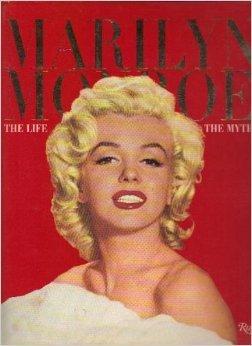
Edited By Giovan Battista Brambilla, Gianni Mercurio, Stefano Petricca
1996 Rizzoli
ISBN 0847819604
Read More


